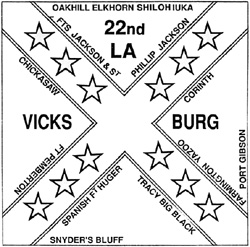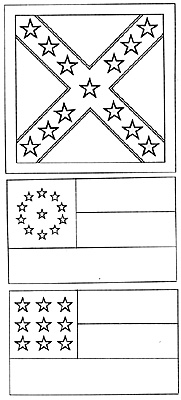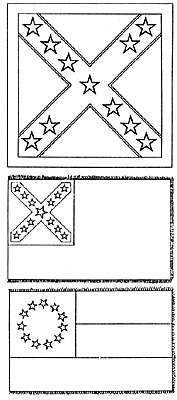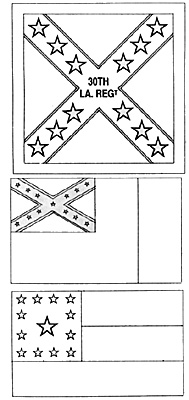After some lengthy delays earlier this year, we seem to be on track again with our flag project. This issue of THE ZOUAVE presents ten flags, of which four are regimental colors, one is a cavalry regiment guidon, three are of battalion or company status, one is an artillery battery color, and the last is a flag used by Jefferson Davis' escort company. The latter flag was captured along with Davis and his military escort.
All of the mail concerning the flags since the last issue has been quite positive. It appears that many of our members are somewhat fanatical about the realism of their painted miniatures and that the illustrations will be put to good use. While THE ZOUAVE is, and has always been, dedicated to ACW gamers, the editor has made no secret of his desire to incorporate historical research in our pages whenever such could be of benefit to members. The flags are deteriorating, and in another century or so, they may not be available f or view to our descendents. Having an illustrated record of them may be all that we can leave to future ACW enthusiasts.
Our most hearty thanks go out to Jill Fisher, a graphic artist who works for our printer. Jill donated her time and skill in producing these illustrations and, to prove her masochistic tendencies, she has offered to do more of the flags for future issues. We're definitely taking her up on the offer!
The editors hereby grant permission for members to photocopy the illustrations, either for their own use in reducing the flags to 15mm size, for further publication in NON-PROFIT publications, or for "show and tell" at the various Civil War Roundtables that exist around the country.
 22nd Lousiana Regimental Flag
22nd Lousiana Regimental Flag
Field - Red; Bars - Blue; Lettering, Stars, and Trim - White
 JEFFERSON DAVIS ESCORT FLAG
JEFFERSON DAVIS ESCORT FLAG
This is the flag that accompanied Jefferson Davis in his travels held by his escort company. The field is red, the bars are blue with white trim, the stars are white, and the borders are trimmed in white.
FENNER'S BATTERY
Organized in Louisiana in 1862, Fenner's Battery first served at Port Hudson. The unit was later assigned to Maxey's Brigade, where it s erved for a time at Jackson and was later sent to Mobile. It joined the Army of Tennessee in April 1864 and was assigned to J.W. Eldridge's Battalion of artillery. The company served in the Atlanta and Tennessee campaigns before being sent to Mobile to aid in the defense of that city, surrendering in May 1865. The bands on the flag are red-white-red, the quarter is blue, and the stars are white.
2nd LOUISIANA CAVALRY REGIMENT
This guidon belonged to the 2nd Louisiana Cavalry, which was organized in the summer of 1862. The unit spent Its entire existence within Louisiana and had many skirmishes with Union forces. Its most severe engagement was at Henderson's Hill on March 21, 1864, where it lost 15 officers and 192 men captured. The regiment was disbanded during the spring of 1865. The bands on the flag are red-white-red, the quarter is blue, and the stars are white.
 8TH LOUISIANA INFANTRY REGIMENT
8TH LOUISIANA INFANTRY REGIMENT
One of the Pelican State regiments that went to Virginia early in the war, the 8th Louisiana was brigaded under Generals R. Taylor, Hays, and York, fighting in Jackson's Valley Campaign and with the Army of Northern Virginia from the Seven Day's Battles to Cold Harbor. It also fought in General Early's battles of the 1864 Shenandoah Campaign. This unit suffered 74 casualties in the Seven Day's Battles, 91 in the Maryland Campaign, 83 at Chancellorsville, and 25% of the regiment at Gettysburg. Only 57 men were left to surrender at war's end. This is one of two flags known to be carried by the 8th Louisiana Infantry. The flag has a red field, blue bars trimmed in white, and gold stars.
12TH LOUISIANA INFANTRY REGIMENT
Serving for a time in Missouri, the regiment was captured at Island #10 in early 1862. The men were soon released and the unit was assigned to Rust's, Buford's, T.M. Scott's, and Lowry's Brigade, fighting at Champion's Hill and Jackson before participating in the campaigns of the Army of Tennessee from Resaca to Bentonville. After losing many men in Hood's Atlanta and Tennessee Campaigns, the 12th Louisiana surrendered with only a few men in April 1865. This particular flag was captured at Peachtree Creek on July 20, 1864. The field is white, while the quarter is the regular stars and bars (red, with blue bars and white stars).
THE ALGIERS GUARDS
No mention of this company is made in any reference books examined by the editor to date. They did not serve in the Eastern Theatre, so the probability is that the unit served in the Trans-Mississippi Department, or in the city of New Orleans as a "home" guard. The flag's bands are red-white-red, the field is blue, the stars are white, and the fringe is silver.
 30TH LOUISIANA INFANTRY REGIMENT
30TH LOUISIANA INFANTRY REGIMENT
The regiment was organized during early 1862 and was later reduced to a battalion. Serving initially in Maxey's Brigade, Dept. of Mississippi and East Louisiana, the unit fought at Raton Rouge and Port Hudson, where it was captured. After being released and the unit reorganized, the 30th later served in Quarles', Page's, and Gibson's Brigade in the Army of Tennessee. It's final duty was at Mobile before the surrender. The regiment contained 260 effectives in August 1862, 322 men in December 1863, and 161 effectives in late 1864. The battle honors are inked onto the gold stars on the flag, with red field and blue bars in gold trim. The lettering is also gold.
9TH LOUISIANA INFANTRY BATTALION (BOYD'S BATTALION)
Formed at Camp Moore, Louisiana, the battalion contained four companies and served in Gregg's and Maxey's Brigade in the Department of Mississippi and East Louisiana. They were captured in the fight for Port Hudson and, after being exchanged, the unit was never reformed. The field is white with a vertical band of red, and the quarter is the regular stars and bars outlined in white.
CRESCENT CITY RIFLES
One of the companies that made up the 1st Louisiana Battalion (Dreaux's Tigers), the Crescent City Rifles fought in Virginia with the battalion until it was disbanded in 1862, the men being transferred to other units. The bands on the flag are red-white-red, the field is blue, and the stars are gold.
More Flags of the Confederacy
Back to The Zouave Vol II No. 4 Table of Contents
Back to The Zouave List of Issues
Back to Master Magazine List
© Copyright 1988 The American Civil War Society
This article appears in MagWeb (Magazine Web) on the Internet World Wide Web.
Other military history articles and gaming articles are available at http://www.magweb.com